1. The MotionMonster is Makin' Parts
2. Short Term Plan
3. The (Pseudo) Hydroforming Process
4. Long Term Plans
5. FWF Update
6. Builder Updates:
a. Chuck Has Gotten His Experimental Certificate
b. Bud's Engine Parts Are Fixed
c. Ray's Engine Work Continues
d. Roy's Airplane is For Sale
e. Bryan's Cranking On His Fuselage
7. XP Talon Info
1. The MotionMonster is Makin' Parts - I've been able to get some time in the shop that past couple of weeks finishing up the installation of the machine and cutting parts. Yep! After 7 months of researching the various components of the machine, figuring out an electric power scheme for it, doing hook-ups, tracing wires, fixing parts, cleaning pieces, getting tooling, figuring out the spindle systems, plumbing chip vacuums, etc. etc. - I finally made some outboard wing spar cap strips with it. These parts had been cut out of a full sheet last March before I knew that I'd be getting this machine. Here's what they looked like then:
I used the CAD drawings that I had made for these parts to run through my CAM software and make the G-code for the machine. But since these parts had already been cut into strips (instead of cutting these out of a full sheet), I had to make a fixture and cut them individually while mounted in the fixture. Here's the fixture I fabricated (with the old pattern laying on top):
Here's a video of the machine cutting the 1/8" rivet holes:
Since I broke all the endmill/cutters that I had in the shop (and the new ones I ordered hadn't arrive before I had to leave to go to work), I couldn't get the outboard wing spar channel pieces cut out. I'll have to get those done when I get home again next week.
Before I left, however, I was able to get another fixture made to put the holes into the center wing spar parts. Here's a couple of pics:
The pic above is the fixture installed on the table. Below is the main center section spar web that I made years ago installed in the fixture. I used the machine to router out a pocket so that the pieces will just fit into the fixture. This will ensure proper rivet hole alignment of all the spar parts (shear web, top cap strips and bottom cap strips).
As I mentioned, I have had these main spar center section parts cut out and laying on one of the benches in the shop for several years. It was while I was making those pieces that I decided that there had to be a better way to more accurately and quickly produce these parts. This got me started down the path of researching and learning about CNC production techniques. The buying, fixing, and installing the various machines that I now have machines then followed. The plan is (slowly) starting to come together. Speaking of plans, that's the next couple of topics.
2. Short Term Plan -
On the near term horizon I have three goals:
A. The first goal is to go back and create the G-code part files for all of the parts of the airplane that I have already made using manual techniques. When I finish the first "new" Prowler plane, I want to have ALL of the parts made using the CNC production processes. Going back and creating the part files for all the parts that I've already made will get the production processes "caught-up" to the parts that I have already made for the first airplane. I've actually gotten most of this done already for the outboard wing spar parts that I drilled and profiled the past several weeks (mentioned above). I'll get the center wing spar parts done in the next week or so.
B. The second goal is to get the 8 foot press brake that Pop and I built last year dialed in and cleaned up. I need to have it working in order to bend the outboard wing spar channels to meet the next goal.
C. The third goal is to get all of the wing spar parts (center and outboard) cleaned up, treated with Alodine, and assembled before the end of March. That's when Pop will be out for the annual visit and he can help me get the spar installed into the wing jig and leveled up. If you go "way back" in the blog posts, you'll see that we built the first phase of the wing jig almost 4 years ago (Mar 2007)! The pieces of the puzzle are SLOWLY starting to come together.
Once the spar is in the wing jig, then the focus will shift to setting up the production processes and making the parts that will eventually attach to the spar. The most significant of these will be: wing ribs (nose and mid); parts associated with the landing gear; and the fuselage floor pieces. The production process I'm hoping to use for the wing ribs is going to lead to the next big phase of production set-up for the "new" Prowler Aviation. I'll outline this in the Long Term Plan below. But first, more on the wing rib forming process.
3. The (Pseudo) Hydroforming Process -
The process that I'm hoping to use for making wing ribs, bulkhead formers and similar parts is best described by Brian Carpenter in a video that he made for the EAA Hints for Homebuilders. Check this out:
Here's how the math works out. It takes a pressure of about 800-1000 PSI to form the metal that you saw in the video above. Let's be conservative and use the 1000 PSI as our target pressure to ensure our parts get bent completely and properly. Now, the largest part that I need to be able to bend using this process is the fuselage former right behind the cockpit. This part is approx. 34" by 22" which will require a "box" that is at least 36"x24" and gives an area of 864 sq. in. Now, if you want to get 1000 pounds of force in every sq inch, that will require a total force of 864 x 1000 = 864K pounds of force. That means you will need a press that is capable of 432 tons! That is a massive press. If you have a minute do a google search for 600 ton hydraulic presses. You'll see that they are massive and expensive. But, I have a plan.
Once the spar is complete and installed in the wing jig the next step will be to begin to "decorate" it with wing ribs and parts mentioned earlier. Creating the production process for making the wing ribs will be a challenge, but it is do-able. In order to be able to practically and feasibly make parts using this "rubber hydroforming" process, the size of the "box" has to be reduced to the smallest size possible. After reviewing all the alternatives, I have decided (with the help of some of my "advisers") to produce the fuselage formers in two parts. The largest 3 of the 8 fuselage formers will have to be made in two halves and those will have to be riveted together by the builders before installation. Not an ideal solution, but it is an acceptable compromise.
So, by doing this, the size of the "box" is reduced to about 36" x 12" and will require about 200 tons of force. Now we are down to talking about two 100 ton presses possibly configured side by side. Or, we may be able to use four 50 ton bottle jacks in a distributed, purpose built press setup. One way or another, doing this makes the production process a lot more practical and a lot less costly. It's doable. Here's a snippet of an idea that I have:
4. Long Term Plans - Looking a ways down the road, the setup for the production of pressed parts will be become the big project into next year. Getting, buying, or building a press with the capability to make these parts (and not break the piggy bank here) will be the next big challenge for me. I'm fairly certain that I can come up with a home-brew, purpose built press like the snippet shown above. But before I spend the time, effort and money to tackle that, I want to try some of this process on a smaller scale.
To do that, I plan to remodel a hydraulic press that we got from George with the sale of Prowler Aviation. Here's a pic of it as it currently exists:
In a "way back" post I talked about getting that press set up for pressing wing ribs using a male and female die process on soft 2024-O aluminum. That was before I discovered this rubber hydroforming process and after I went through the heat treating process that I also discussed in a previous post. To be able to make these parts in a two step process (#1 cut from a full sheet of 2024-T3 and #2 press into shape in one operation) will greatly simplify my production.
Anyway, I'm going to first test this process out with this smaller press. I plan to remove the wood platens and replace them with the largest steel "box" that I can use in this press, given the 100 ton ram that is in it and the physical size of the press between the left and right columns. I hope to be able to make a box just big enough to be able to form almost all of the wing ribs for the airplane. Then, taking what I learn from this endeavor, I will set out to design and build a purpose built press big enough for all of the Prowler parts I will need to "squish."
Before I can squish out any of these parts, I will need to make new dies similar to what you saw in the video with Brian. Since I plan to (hopefully) re-use these dies many times (meaning lots of kits), I will need to make new dies for any part that has to be squished to become a real Prowler part. That's where this guy comes into play:
Remember the summer before last, when the opportunity to get this machine for a really good price came along? Well, it's time will come (soon), and the overall plan is slowly coming together. I'll be using this to make those dies out of thick aluminum, or maybe mild steel. Also, while I was doing all the CAD work and making the drawings of all of the parts of the plane, I knew that this would have to be done - so I also made the necessary drawings for the dies (to perfectly match the parts) at the same time. Now, I will have those readily available when I need to start cutting dies. The pieces of the puzzle ......
It also turns out that the controller that I'm learning to use to run the MotionMonster is a Fagor 8025M controller. And, the controller on the 3axis CNC Ganesh mill is a Fagor 8040M - same company, just a few versions newer. So, much of what I'm learning on the router will apply (and flatten the learning curve) to the Mill. That was kind of convenient! You'll see more of this toward the end of 2012 and into 2013 - I suspect.
5. FWF Update - In the past few months, there has been some things happening at GearedDrives. Larry, who worked for Bud and Phylis, has taken over as moderator of their Yahoo Groups site. Some of their builders are discussing their installations, etc. But, no word yet on what will become of the company. In order to plan ahead conservatively, I've taken some time to follow up on some suggestions from some of my "advisers" and I've looked into the company called EPI again. I had checked out their website several years ago, but hadn't for a long time. Well, now I think it will serve me well to investigate this as a resource for possibly obtaining a good FWF solution for the Prowler. I have only looked over the information on the website, but I have not contacted the company directly. It's on the list of to-do's. But I'd thought I'd share the info. If any of you have information about EPI and/or Jack Kane - I'd be interested to hear your insight. You can check out their website here: http://www.epi-eng.com/index.html and specifically the PSRU gearboxes here:http://www.epi-eng.com/gearbox_products/gearbox_products_contents.htm
6. Builder Updates:
A. Chuck Has Gotten His Experimental Certificate - Chuck called me recently to report that he got his airplane put all back together after his gear-up landing incident and that he has received his experimental certificate. He still reports that the airplane flies beautifully. He is really impressed with the great handling characteristics of the airplane and it's responsiveness. He's looking forward to taking his wife out on a few short trips soon. Congratulations Chuck! Thanks for the update and enjoy the rides!
B. Bud's Engine Parts Are Fixed - Here is the body of the most recent email that I got from Bud:
"After six months, I finally have my engine back and will begin reinstalling it tomorrow. Along the way, I have learned a lot about Chevy SB engines and mine in particular. I think I know most of what George did to produce it. In a way, I am lucky to have had this opportunity to disassemble and rebuild the engine; I feel more comfortable with it now."
Good Luck with the re-installation of your FWF setup Bud. Please send updates with your progress. And, let me know if I can help in any way.
C. Ray's Engine Work Continues - Ray is continuing to make good progress on his airplane. I was able to make a run up to see him this past week (crew services was leaving me alone for a while - finally). He has gotten a lot of cockpit re-installed to near military specs. The camera blurred a bit, but check this out:
His engine is still apart while he has his heads re-worked, but he's done a awesome job working on the systems and the engine hook-up. Here's some examples:
And, here is his new composite propeller that will grace the front of his airplane. It's a really nice prop, and composite for this application is a good choice.
Unfortunately, Ray is sked for surgery in Jan and Feb. So, it won't be until after his recovery that he will be able to get his engine work completed and run it for the first time. He is estimating at he might get his first runs done in April or early May. I can't wait to hear his plane start. I plan to be there if I possibly can. I'll report with pics and video. Good luck with the surgery Ray. We all hope you recover well and quickly.
D. Roy's Airplane is For Sale - Sadly, Roy reports that he must put his Prowler up for sale. Here is the text from a couple of his emails:
"I sure hate to have to do it, but I have no choice. I am going to have to put kit# 13 up for sale. If you guys know of anyone that might be interested please give them my contact info. (Please use the Contact page on our website and I will provide the contact info if you are interested). I have included a couple of pictures of the project
I purchased the project about 2 years ago for $30,000 I haven't touched it except for putting it together to look at. The workmanship is very good and I believe its worth the price. The A&P that was working on it has 5 years of full time work in it. It will significantly reduce the build time for the next owner. Let me know if your interested and we can talk further."
Here are the pics that Roy included in his email:
I am really sorry to hear this bad news Roy. I hope your airplane finds a great home! Again, please use the Contact page on our website if you are interested. I will send you Roy's contact info.
E. Bryan's Cranking Away On His Fuselage - Brian sent this update with some pics:
"Any previous builder can sympathize with where i am at with this project... those pesky tail (aft fuselage) skins! Having evaluated all the previous experiences builders have had trying to make this work I decided to English wheel the skins prior to fitment. I have had some success with that idea as the limited number of tie down straps attest. The side skins are troublesome because of their 8' length. Trying to stabilize them while rolling only one edge is unsettling to say the least. The question most asked... Yes, I also had to shim the bulkheads (up to 1/4" in one place) to get a good fitment. So, two steps foreword and one step aft as i discovered i had over tightened several of the hydraulic lines under the cockpit floor. Fortunately I can still lift the floor and re-do those lines before access to that area becomes severely restricted. I would have attached a big red bow for the season but have to run off and ream my motor mounts at a friends house before he leaves for a trip."
Great progress Bryan! Thanks for the pics.
7. XP Talon Info - You might remember that I mentioned the XP Talon in my last blog post. I didn't have a picture of Chuck's unfortunate gear-up incident, but I did have a pic of a similar incident that the XP Talon was involved in. Well, that post prompted an email to me from Vern Goodsell. Vern's a real nice fella. In one of his emails he said:
"I talked to Chuck the day he skidded his Prowler in and we both felt sorry for each other. I had done the same thing two weeks earlier! The Talon is back in the air and flying well. I hope Chuck is close to flying the Prowler but I haven't heard from him.
There is quite a story about how and why the Talon was designed and built but the original owner never finished it. I purchased it in 1997 and worked on it off and on 'til it flew last January.
I always liked the Prowler and actually flew the Jaguar with George years ago. You prowler owners are lucky to have at least some kind of back-up and support, I have the only Talon in the world and no spare parts or support to go with it. But I like a challenge and when something gets bent, I get to work and fix it.
The Talon will be for sale when I finish flying the hours off so if any of you pilots out there are interested, just give me a call or email me."
Thanks for the email's Vern. We're happy to report (above) that Chuck has indeed gotten his Prowler back in the air. Congrats on completing such a unique and beautiful aircraft. It looks like you've done a fantastic job. You never know, maybe 1 of my 2 blog followers might be interested in buying your airplane!?!?
That's all for this update. Thank you for stopping by to check in on us. Merry Christmas from Prowler Aviation. I hope you all enjoy a happy and safe holiday season.
















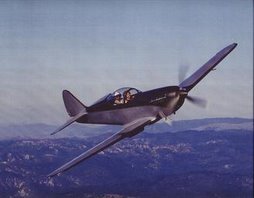
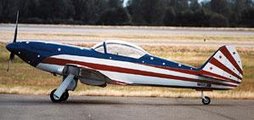
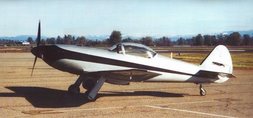
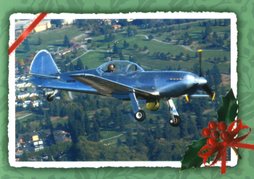
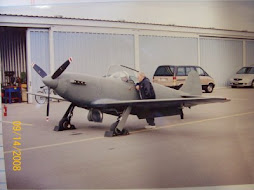
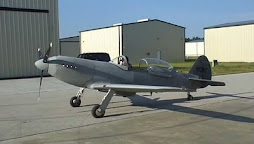

1 comment:
hi
im daniele from italy
i see the outboard wing cap strips and what is' the thickness ?
thank
Post a Comment